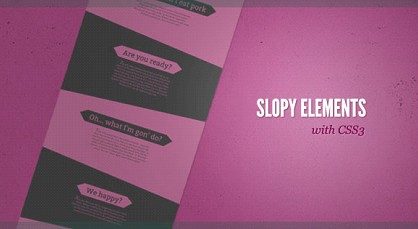Creating Slopy Elements with CSS3
Web development guru Manoela Ilic shares a cool CSS3 tutorial on creating slopy, skewed elements for your design. It’s inspired by different designs that use angled shapes, diagonal lines and other non-straight elements.
Sample 1:
section> <div> <article> <h3>Some headline</h3> <p>Some text</p> </article> </div> <div> <!-- ... --> </div> <!-- ... --> </section>
Style
CSS
The body will have similar background color which is pink.
body{ background: #e90089; }
Hide the main wrapper and pull rotated elements in a way that it would stick out .se-container{ display: block; width: 100%; overflow: hidden; padding-top: 150px; }
Add a negative top margin
.se-slope{ margin: 0 -50px; transform-origin: left center; } .se-slope:nth-child(odd){ background: #000; transform: rotate(5deg); margin-top: -200px; box-shadow: 0px -1px 3px rgba(0,0,0,0.4); } .se-slope:nth-child(even){ background: #e90089; transform: rotate(-5deg); box-shadow: 0px 2px 3px rgba(0,0,0,0.4) inset; }
Center the article
.se-content{ margin: 0 auto; }
Create some asymmetric triangles on both sides using the transparent border trick
.se-content h3{ font-size: 60px; position: relative; display: inline-block; padding: 10px 30px 8px 30px; height: 80px; line-height: 80px; margin-bottom: 20px; font-family: 'Bitter', 'Trebuchet MS', Arial; text-shadow: 1px 1px 1px rgba(0,0,0,0.9); } .se-slope:nth-child(odd) .se-content h3{ background: #e90089; color: #000; } .se-slope:nth-child(even) .se-content h3{ background: #000; color: #e90089; } .se-content h3:before{ content: ''; width: 0; height: 0; border-top: 38px solid transparent; border-bottom: 60px solid transparent; border-right: 60px solid black; position: absolute; left: -59px; top: 0px; } .se-content h3:after{ content: ''; width: 0; height: 0; border-top: 38px solid transparent; border-bottom: 60px solid transparent; border-left: 60px solid black; position: absolute; right: -59px; top: 0px; }
Adjust the color for the odd elements
.se-slope:nth-child(odd) .se-content h3:before, .se-slope:nth-child(odd) .se-content h3:after{ border-right-color: #e90089; border-left-color: #e90089; }
Style for the paragraph will be the following .se-content p{ width: 75%; max-width: 500px; margin: 0 auto; font-style: italic; font-size: 18px; line-height: 24px; padding-top: 10px; }
Styling the first letter differently
.se-content p:first-letter{ font-size: 40px; font-family: 'Adobe Garamond Pro', Georgia, serif; }
Rotating the article back to 0 and adjusting the paddings to fit the content nicely .se-slope:nth-child(odd) .se-content{ transform: rotate(-5deg); color: #e90089; padding: 130px 100px 250px 100px; } .se-slope:nth-child(even) .se-content{ transform: rotate(5deg); color: #000; padding: 150px 100px 250px 100px; }
You may check out her other samples and learn how you can create them as well. For her full tutorial, click on the image.







